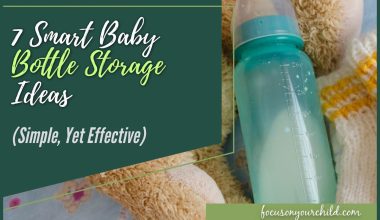Babies make a wide range of noises which they use to communicate with their caregivers long before they produce their first word. Aside from the typical sounds such as crying, cooing, and gurgling, babies are also capable of making sounds while they feed, to indicate contentment, discomfort, and even difficulty feeding.
A clicking sound while bottle feeding usually indicates a loss of suction and/or repeated attempts to get a good latch on the bottle nipple. If you notice your baby making clicking sounds while drinking from a bottle, the quickest fix is just to take the bottle out of their mouth, reposition it, and try again.
There are a few reasons why your baby might make a clicking sound while feeding, such as an improper or shallow latch, incorrect nipple size, teething, and even an ear infection. Once you figure out the underlying reason for the clicking, you can work on fixing the problem and getting a good experience out of bottle-feeding your baby.
What Makes the Clicking Sound?
Just like with breastfeeding, bottle-fed babies need to get a good latch on the silicone nipple to feed properly. A clicking sound might occur when your baby isn’t able to suck on the bottle nipple properly, and ends up sucking on their tongue or cheeks instead.
The clicking is produced similarly to the “tsk tsk” sound you might make to express distaste, although it might not be as loud or clear as an adult would make it.
While hearing your baby clicking while feeding can be concerning, it is not always a bad sound to hear.
While consistent clicking with every feed is a concern that suggests a feeding issue that needs to be addressed quickly, the odd click here and there while feeding isn’t necessarily something to worry about, provided that your baby is otherwise healthy, feeding well, and gaining weight.
Reasons Why You Hear A Clicking Sound While Bottle Feeding
Poor Latching
A good latch on the bottle nipple is just as important as a good latch on a human nipple. The techniques for getting a good latch on a bottle nipple are fairly simple and similar to the techniques used for a breastfeeding latch.
Use the tip of the bottle nipple to tickle your baby’s lip and nose. This will stimulate their rooting reflex and get them to open their mouth wide. Insert the nipple with the bottle angled up towards their hard palate.
Check to see that the nipple is positioned over and not under the tongue. The protruding tip should be entirely inside their mouth. Gently push their lower lip upwards to help them seal their lips around the nipple until they latch on completely.
Body and Bottle Position

The wrong body posture can make it hard for your baby to maintain a proper latch on a bottle nipple. Hold your baby to your chest at a 45-degree angle and hold the bottle horizontally with a very slight tilt. An angled baby bottle may also be more ergonomic and allow for a better latch with upright feeding.
It is also important that you keep a comfortable position while holding the bottle for your baby. You can use a nursing pillow to prop your baby up and reduce the amount of work your arms need to do to support them.
Nipple Flow Rate
As you may know, bottle nipples come with different sizes or numbers of holes, to allow for different levels of milk flow. Using a nipple with too high or low of a flow rate can make it difficult for your baby to feed properly and cause them to click.
Signs of a nipple flow rate being too high include milk leaking out from the sides of your baby’s mouth, gulping, coughing, gasping, or sputtering while feeding, and finishing bottles very quickly (in less than five minutes). Your baby may also struggle to swallow in between sucks when milk is coming into their mouth too quickly.
Signs of a nipple flow rate being too low include flattened or collapsed nipples from your baby sucking too hard, taking more than half an hour to finish feeding, and eating less and getting hungry quickly after feeding. A too slow flow rate may also cause your baby show signs of frustration by crying, squirming, or pulling away from the bottle.
Generally, you’ll want to start with the slowest flow rate available for that particular nipple and move up as needed. There are also recommendations for nipple flow rates by age, as can be seen here.
Incorrect Nipple Shape
If the nipple tip is too long or too large, your baby may gag on it or push it out of their mouth to avoid gagging. Gagging, grimacing, shallow latching, and clicking may mean that the nipple is too long for them and you may need to switch to a shorter or smaller nipple.
The shape of the bottle nipple matters too. With a breastfed baby, you want to choose a bottle nipple with a gradual slope and narrower base that will allow your baby to take all of or most of the silicone portion of the nipple into their mouth and seal their lips close to the O-ring collar, much like they would with a deep breastfeeding latch.
With bottle nipples with a narrow tip and a suddenly wide base, your baby may end up sucking on the tip like a straw. Dimpled or hollow cheeks are usually a sign of straw drinking. They may also try to take the base into their mouth, creating an air pocket that will prevent a proper seal from forming and cause them to swallow more air while feeding.
Nipple Tip Shapes
Generally speaking, bottle nipples that bear a similar rounded bulb shape to a human nipple are best for breastfed or combination-fed babies. You want your baby to maintain the same oral posture at the bottle as they do at the breast. This helps prevent nipple confusion and potential pain or damage to your nipple later on.
Orthodontic nipples that are flat on one side and rounded on the other (like lipstick) are designed to prevent teeth misalignment and malocclusion. The rounded side rests against your baby’s palate, while the flatter bottom and tapered sides put less pressure on your baby’s teeth and jaw.
Orthodontic nipples may also be easier on a teething baby’s gums and a pediatric dentist may recommend switching to one once your baby begins teething. If you think your baby’s clicking is related to teething soreness, ask a pediatrician or a dentist about using an orthodontic nipple.
Teething
Your baby may be using the bottle nipple like a teether, chewing on it to massage their gums instead of sucking on it to draw milk out. Help relieve the soreness in their gums before a feed by offering a cold teether for a few minutes before you bring out the bottle.
Tongue and Lip Ties
Tongue ties are caused by a shortened lingual frenulum, aka the bit of tissue that anchors your tongue to the floor of your mouth. Lip ties are similar – the labial frenulum, which connects the underside of your upper lip to your gumline is abnormally shortened.
Tongue ties and lip ties limit the range of motion of the oral structures that would normally assist in sucking and swallowing. Clicking sounds while feeding is a common symptom of tongue and lip ties.
A frenectomy is usually done to release tongue ties and lip ties. Using scissors or a laser, a surgeon cuts and modifies the tissue to allow the affected structure, in this case, the tongue or the lip, to move normally. The procedure is typically performed under local anesthesia and causes little to no pain or discomfort. Babies can feed immediately following the procedure.
Temporary Illness

Some mild illnesses and infections can cause your baby to change the way they feed, causing them to click. Clicking that occurs while your baby is sick will most likely resolve once they get better.
Congestion
If your baby has a cold and is congested, they will need to break the seal to breathe through their mouth every few sucks.
Using a rubber bulb syringe or nasal aspirator can help clear the mucus from their nasal passages and allow them to breathe through their nose while feeding. Saline nasal drops can also help loosen the mucus and make it easier for them to breathe through their nose.
Ear Infections
Sucking and swallowing can cause pressure changes in the middle ear that may exacerbate ear infection pain. When a baby has an ear infection, they may change the way they latch on to a bottle to make themselves more comfortable. They may also repeatedly break the seal as a way to relieve pressure.
Thrush
While oral thrush is easily treatable and rarely serious, it does cause itching and soreness in your baby’s mouth, which may cause your baby to click and break the seal around the nipple.
Cleft Lip or Palate
Often, babies with a cleft lip only (no palate involvement) can feed well enough with normal breastfeeding or bottle-feeding. There are also bottle nipples shaped to help babies with clefts eat properly.
A cleft palate, on the other hand, opens up the division between the oral and nasal cavity, making it difficult for babies to create the pressure vacuum that allows them to suck. It can also interfere with the normal function of the muscles that facilitate swallowing at the back of the mouth.
Some types of cleft palate are not always visible. Submucosal cleft palates are covered by a layer of mucosa (tissue) and may be missed during a newborn oral exam. There are, however, common signs of submucosal clefts, such as a bifid (split) uvula, and a pale bluish tint along the roof of the mouth.
A speech-language pathologist that specializes in pediatric feeding may be able to help you find techniques that can help your baby feed well. Clefts that are diagnosed at birth are usually repaired through surgery within the first 18 months of life.

